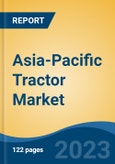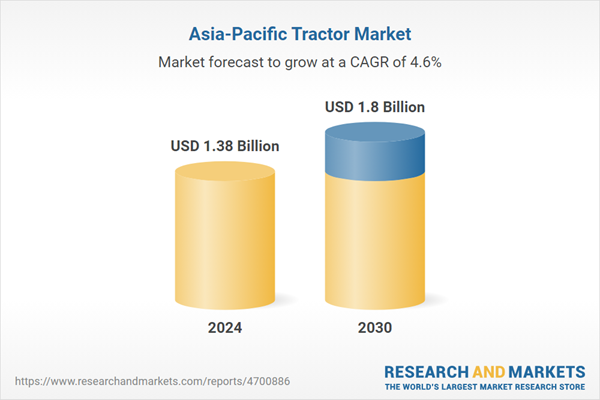Speak directly to the analyst to clarify any post sales queries you may have.
10% Free customizationThis report comes with 10% free customization, enabling you to add data that meets your specific business needs.
Market Drivers
Rising Demand for Agricultural Mechanization
One of the primary drivers propelling the Asia-Pacific tractor market is the growing demand for agricultural mechanization. As traditional farming methods prove increasingly insufficient to meet the needs of a growing population, farmers are transitioning toward mechanized solutions that enhance productivity and reduce manual labor. Tractors play a crucial role in this transition by performing various tasks such as plowing, sowing, harrowing, and hauling. In densely populated countries like India and China, where agriculture remains a key component of the economy, mechanization is seen as vital to boosting crop yields and ensuring food security.Small and medium-sized farmers are becoming more aware of the long-term benefits of tractors in terms of efficiency, time savings, and output, leading to increased adoption across both developed and developing nations in the region. Furthermore, government programs promoting the use of modern farming equipment have contributed to raising awareness about the importance of mechanization in agriculture, thereby fueling market growth. For instance, according 2025 report, tractor ownership in Uttar Pradesh, India, increased by over 62% from 2016-17 to 2024-25, rising from 88,000 to 142,200 units, supported by subsidies and mechanization programs.
Key Market Challenges
High Initial Cost and Limited Access to Financing
One of the most significant challenges facing the Asia-Pacific tractor market is the high upfront cost of purchasing tractors, especially for small and marginal farmers. Tractors represent a substantial capital investment, and many farmers in the region lack the financial capacity or access to formal credit systems to afford such purchases. In rural and underdeveloped areas, banking infrastructure is often weak, and farmers may be excluded from mainstream financial services.This makes it difficult for them to secure loans or financing options necessary to buy agricultural machinery. Even where subsidies and government schemes exist, delays in disbursement or complex bureaucratic procedures can hinder timely access to these benefits. Additionally, the maintenance, repair, and fuel costs associated with tractor ownership can further burden farmers, especially those with limited or seasonal incomes. As a result, many continue to rely on traditional, labor-intensive farming methods or opt for renting tractors instead of owning them, which limits long-term market penetration.
Key Market Trends
Electrification and Emergence of Sustainable Tractors
One of the most prominent trends in the Asia-Pacific tractor market is the rising interest in electric and hybrid tractors, driven by increasing environmental awareness and regulatory push for low-emission technologies. As governments across the region emphasize reducing carbon footprints and encouraging sustainable agricultural practices, manufacturers are investing in the development of eco-friendly tractors. Countries like China, Japan, and South Korea are leading the way with pilot projects and incentives for electric farm machinery.Electric tractors offer benefits such as lower operational costs, reduced noise pollution, and zero emissions, making them an attractive alternative to conventional diesel-powered models. While the high upfront cost and lack of charging infrastructure still pose challenges, ongoing research and development, coupled with government support, are expected to accelerate adoption over the coming years. This trend reflects the broader movement toward sustainability in agriculture, aligning with national goals related to climate change and green growth.
Key Market Players
- AGCO Corporation
- CNH Industrial America LLC
- Deere & Company
- KUBOTA Corporation
- J C Bamford Excavators Ltd.
- Argo Tractors SpA
- Kempston Agri
- Kubota SA
- Escorts Ltd
- Mahindra & Mahindra Limited
Report Scope:
In this report, the Asia-Pacific Tractor Market has been segmented into the following categories, in addition to the industry trends which have also been detailed below:Asia-Pacific Tractor Market, By Power Output:
- >40 HP
- 40-100 HP
- More than 100 HP
Asia-Pacific Tractor Market, By Drive Type:
- 2-wheel Drive
- 4-wheel Drive
Asia-Pacific Tractor Market, By Application:
- Agriculture
- Non-Agriculture
Asia-Pacific Tractor Market, By Country:
- China
- Japan
- India
- Indonesia
- Thailand
- South Korea
- Australia
Competitive Landscape
Company Profiles: Detailed analysis of the major companies present in the Asia-Pacific Tractor Market.Available Customizations:
With the given market data, the publisher offers customizations according to a company's specific needs. The following customization options are available for the report.Company Information
- Detailed analysis and profiling of additional market players (up to five).
Table of Contents
Companies Mentioned
- AGCO Corporation
- CNH Industrial America LLC
- Deere & Company
- KUBOTA Corporation
- J C Bamford Excavators Ltd.
- Argo Tractors SpA
- Kempston Agri
- Kubota SA
- Escorts Ltd
- Mahindra & Mahindra Limited
Table Information
| Report Attribute | Details |
|---|---|
| No. of Pages | 131 |
| Published | August 2025 |
| Forecast Period | 2024 - 2030 |
| Estimated Market Value ( USD | $ 1.38 Billion |
| Forecasted Market Value ( USD | $ 1.8 Billion |
| Compound Annual Growth Rate | 4.5% |
| Regions Covered | Asia Pacific |
| No. of Companies Mentioned | 10 |









